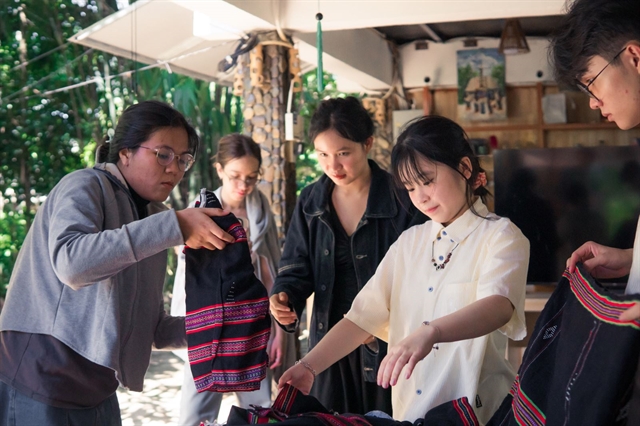 Features
Features
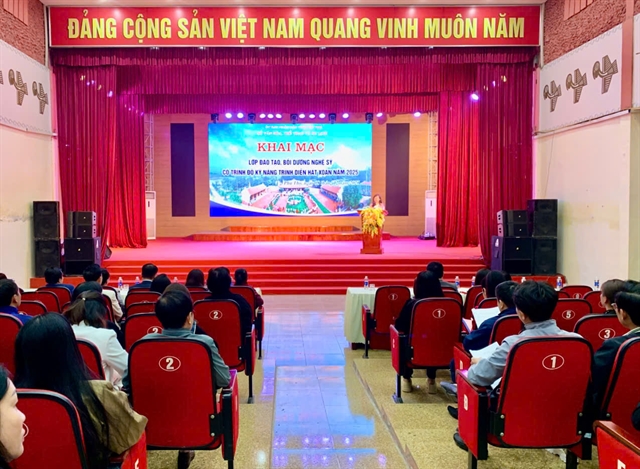
By Việt Dũng
While the Mekong Delta province of An Giang is famous for pilgrimages, it is also a great place for nature lovers to visit.
My family arrived at the Trà Sư Cajuput Forest Eco-tourism Site in Tịnh Biên Town on a lovely Sunday morning with the weather being just right for some fun outdoor activities.
While it was a long two-hour drive from where we were staying in Long Xuyên District, we were eager to find out why this place was so popular with tourists.
When you enter the place, you could definitely sense the huge investment and effort that must have gone into all the beautiful decorative pieces such as bamboo bridges, flower gardens and replicas of traditional buildings.
They were made just for taking photos, it seemed.
Looking at the tourists hanging out there, couples riding bicycles under the shade of the trees, foreign visitors taking photos, and people walking around in their rented traditional bà ba blouses, we could tell we were in for a good time.
A major attraction here is the 30-minute boat tour on a river.
 |
| Many visitors love taking photos during a boat ride in An Giang Province's Trà Sư Cajuput Forest Eco-tourism Site. VNS Photo Việt Dũng |
Our motorboat with 10 tourists chugged along the river that was sprinkled with fallen leaves and floating greenery.
We sat back and enjoyed the ride, looking at the wide variety of plants and birds flying in the sky, perching on tree tops and even hanging out on some branches near us.
The tour guide told us interesting stuff about the birds and plants that we encountered, which made for a fun and educational trip.
Lorenzo Castro, a tourist from Spain who was on the boat with us, clearly enjoyed the trip. He told Việt Nam News that he liked being immersed in nature and listening to the sounds of the birds, which he found very relaxing.
For those who prefer a slower and more leisurely trip to admire the scenery, a rowboat tour is also available.
After the trip we got to see a small apiary, where visitors were both wary and fascinated when the beekeeper pulled out a hive swarming with buzzing bees.
A foreign visitor tasted some honey straight from the hive, her face beaming with a smile at the experience.
We visited the “City of Pigeons”, a place with white, eye-catching pigeon houses built on large wooden pillars that had birds popping in and out or foraging on the ground.
Whenever someone bought some seeds to feed them, a swarm of birds would rapidly flock to the happy person. Everyone I saw doing it had a huge grin on their faces, and so did I.
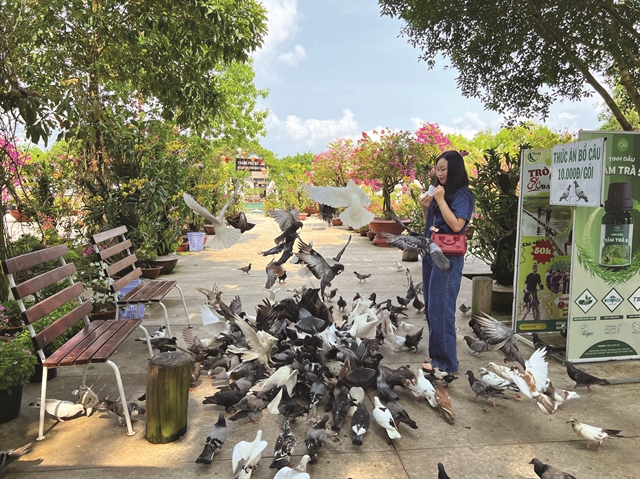 |
| Feeding pigeons is a fun that brightens the face of seemingly everyone who tries it. VNS Photo Việt Dũng |
We were only there for the morning, and so missed a lot of other fun activities such as rowing around in coracles, fishing and farming. One can easily spend a whole day here.
The Trà Sư Cajuput Forest Tourism Site, recognised in 2023 as an "exemplary tourist destination" in the Mekong Delta, has been attracting tourists from all over Việt Nam, offering not only entertainment but also educating visitors about animals, plants and even farming.
There were 845ha of cajuput forests, with 159ha being used for ecotourism and 20ha for a park, and it receives over 200,000 visitors a year.
It is home to around 70 species of birds, 140 plants (both land and aquatic), and many types of reptiles and fish.
An Giang has been focusing on developing tourism, especially of the ecological variety.
It has numerous tourism destinations that make use of its natural advantages, such as the Núi Cấm Tourism Site and Núi Sập Tourism Site, which exploit its majestic mountains.
Another noteworthy place is the Cồn Én Eco-tourism Site in Chợ Mới District, which has been receiving plenty of attention and positive word of mouth since it opened last year.
We were impressed with all the beautiful wooden statues and decorative pieces that greeted us as we entered the place.
Many families and groups of friends had fun posing for photos.
An eye-catching feature at the entrance was a vast wooden bas-relief depicting the scenery of Việt Nam’s countryside.
Its small intricate details portraying trees, landscapes, farmers, and other figures had visitors admiring them.
The work of art is 24.5m wide and 1.8m tall in places, and reportedly took artists and artisans seven years to create.
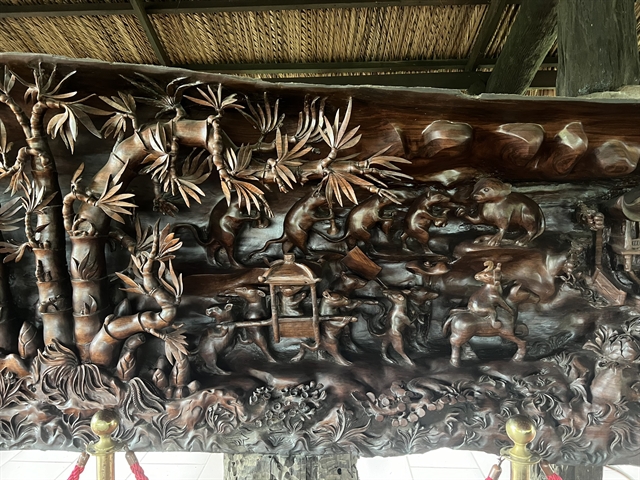 |
| A segment of a vast wooden bas-relief depicting the scenery of Việt Nam’s countryside at the Cồn Én Eco-tourism Site. VNS Photo Việt Dũng |
The wood for the art piece as well as the furniture at the place came from the site owner’s collection of driftwood he has been gathering from the nearby Tiền River for years.
There are also many other appealing wooden decorations, buildings with unique structures and shapes and massive boats that serve as cafes.
They are a feast for the eyes for anyone who appreciates art.
 |
| The eco-tourism site has a slew of visually appealing artworks made of wood. VNS Photo Việt Dũng |
Nguyễn Thị Thanh, a tourist from Sa Đéc Town in nearby Đồng Tháp Province, told Việt Nam News that she and her friends, all retirees, were greatly impressed by the artworks they saw, down to the furniture.
She also enjoyed the natural aspect of the place, and thought it would be a comfortable place to spend time on hot and sunny days.
Nguyễn Thị Ngọc Yến, manager of the Cồn Én Eco-tourism Site, said being located right next to the Tiền River meant the place could offer riverine activities.
“We have several areas here where visitors can go for a swim like on a beach and play folk games in a water park," she said.
“Most of our customers are family groups, people aged around 50-60 and above, and university students. People come here for family trips and team-building activities.”
Though the place is relatively new, it has begun to get visitors from all over Việt Nam during holidays.
 |
| Team building is among the main activities of young visitor groups to the Cồn Én Eco-tourism Site. - Photo courtesy of Cồn Én |
Helping hand to tourism development
An Giang, with its abundance of beautiful landscapes and cultural and historical heritage, attracts millions of tourists every year, and is the leading destination in the Mekong Delta.
Last year it received around 8.5 million visitors, a 13 per cent increase from 2022.
A large number of visitors also come on pilgrimages to its many beautiful ethnic Khmer pagodas of great religious importance and major festivals such as the Vía Bà Chúa Xứ (The Lady of the Realm) Festival on Châu Đốc’s Sam Mountain.
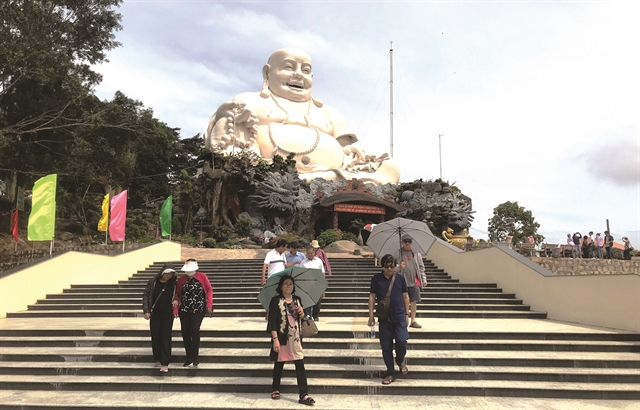 |
| An Giang Province's Núi Cấm Tourism Site is a popular destination set against a mountain. VNA Photo |
Lê Hoàng Ân, director of the Trà Sư Cajuput Forest Eco-tourism Site, said his business received support from local authorities and agencies such as the Department of Culture and Tourism and the Tịnh Biên Town People's Committee [Municipal administration] for tourism development and workforce training.
It also worked with relevant authorities to conserve local flora and fauna.
Yến said the Cồn Én Eco-tourism Site got support from local authorities in terms of business facilitation and promotion, especially of its discount deals during holidays.
An Giang targets nine million tourists this year, and is working on a number of key tasks to achieve this, including creating new attractive tourism products, cooperating with other Mekong Delta provinces and HCM City for tourism promotion and development and providing guidance to localities with high tourism potential in areas such as cuisine, natural resources and culture.
It will focus on utilising its rivers, mountains and forests, agriculture and historical and religious heritage to develop its tourism in a green and sustainable manner.
For any city or province, making use of what nature has blessed it with and building on its cultural and historical foundations are key to developing its tourism, as evidenced by Đồng Tháp and its iconic lotus flowers.
An Giang is certainly taking this lesson to heart in its bid to become a tourism magnet. VNS




